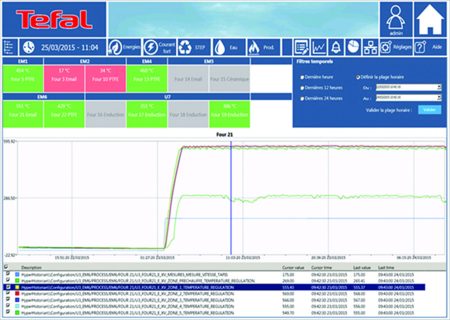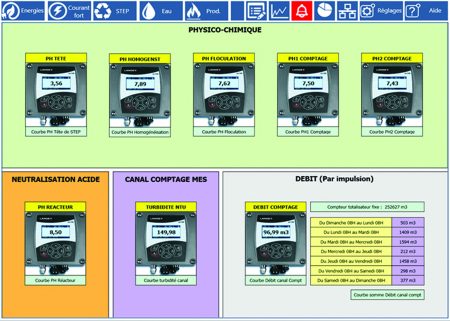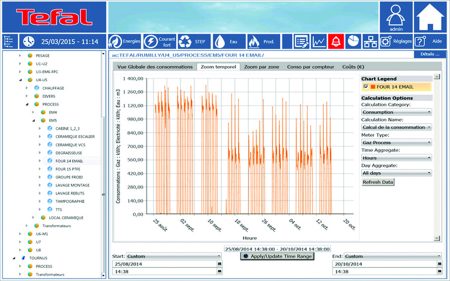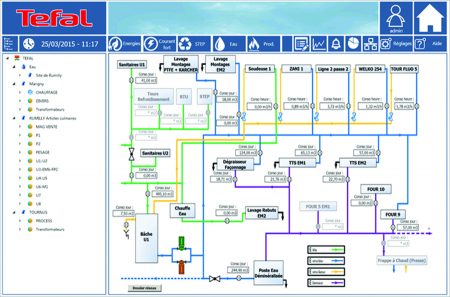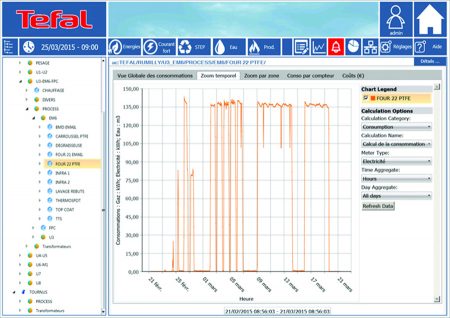“This transition helps us improve our energy efficiency. Digital tools allow us to connect objects, such as gas or electricity meters, in order to monitor our consumption in real time and to alert company personnel at all levels. ICONICS is a Microsoft partner and this relationship has allowed us to install a solution for our energy management that is sustainable and scalable. This energy metering project, and in particular the installation of ICONICS software, has allowed us to create energy key performance indicators that are published at each level of the company for maximum visibility.”
-Cédric Delavallade, Energy Manager, Tefal SAS
About Tefal SAS
 Tefal SAS, headquartered in Rumilly, France is a subsidiary of Groupe SEB, a “world leader in small household equipment”. Groupe SEB, which estimates it sells six products across the globe per second (adding up to 200 million products sold every year throughout 150 countries), has approximately 25,000 employees spread through 29 manufacturing sites worldwide. Tefal’s Rumilly location employs approximately 1,850 people within 160,000 square feet of building space, with an additional 160 employees in Tournus, France within 21,000 square feet.
Tefal SAS, headquartered in Rumilly, France is a subsidiary of Groupe SEB, a “world leader in small household equipment”. Groupe SEB, which estimates it sells six products across the globe per second (adding up to 200 million products sold every year throughout 150 countries), has approximately 25,000 employees spread through 29 manufacturing sites worldwide. Tefal’s Rumilly location employs approximately 1,850 people within 160,000 square feet of building space, with an additional 160 employees in Tournus, France within 21,000 square feet.
Software Deployed
Working directly with ICONICS France, Tefal SAS selected ICONICS’ GENESIS64™ HMI/SCADA suite; Hyper Historian™ high-speed, robust data historian; AnalytiX® suite of analytical tools (including the Energy AnalytiX advanced energy management software); WebHMI™ Web-based, real-time automation software; ReportWorX™ enterprise reporting, charting and analysis software; and BridgeWorX™ real-time workflow for data bridging.
Project Summary
Every year, Tefal manufactures around 44 million products in what was a high energy-consuming process. The manufacturing process entails many phases, including cooking, drying and cooling. The energy costs for manufacturing operations could hit as high as eight million euros, split between four million for electricity costs and four million for gas. Considering these numbers, top management at Tefal decided to launch an Energy Efficiency project to reduce manufacturing-related energy costs.
Tefal began the project by performing an energy audit, in order to learn real-time consumption levels towards the goal of making improvements leading to energy-related savings. The company had several initial objectives at the launch of their Energy Efficiency project. They wanted a map of their energy (electricity, gas and water) consumption in order to prioritize actions for the higher consuming machines, to use for future comparison of past consumption and to validate the expected financial gains compared with initial estimates. Tefal required the establishment of Energy KPIs to be published to key team members (including the site director, technical director, management controller, manufacturing manager, facility manager and multiple operators) to notify them of energy-related gains. The company also wanted a clear indication of energy/electricity availability in order to prepare for new manufacturing projects, optimize energy contracts and be able to meet French energy regulations.
Tefal sought an energy management system that could be implemented without revising their existing architecture. They aimed to connect the new system to equipment already in place, using standard communication protocols such as OPC and OPC UA, for use of real-time data in addition to archiving and recovery. The planned solution needed to interface with multiple pieces of equipment including Allen-Bradley, Eaton Moeller and Schneider Electric PLCs (via OPC), a Socomec power device (also via OPC) and a Producim MES system (via SQL query in an Oracle database). It also needed to be easy to use, to provide access via Web clients without installation, and to manage different needs including monitoring, reporting, commanding, Geo-SCADA/mapping, alarm management and trend management. Tefal’s selected solution would also need to integrate with existing Microsoft components (SQL Server, Excel, etc.), manage consumption of electricity, gas and water (including a way to easily add meters), and provide energy cost management capabilities.
Benefits of the System
Tefal ultimately decided upon installing ICONICS software solutions, which now handles data from multiple meters and transformers, as well as energy data coming from the PLCs. Additionally, the system handles manufacturing data from the MES system (for instance, the number of pieces manufactured) to calculate energy consumption per manufactured piece. The energy data from the existing building automation software helps to calculate Degree Days (representing the difference between the average daily temperature for a location and a baseline value – usually around 18º C or 65º F). The data from 245 energy meters, 14 energy-related PLCs, 24 power-related devices and nine manufacturing-related PLCs can be visualized in real-time dashboards via Web clients or stored via data historian.
With its new ICONICS energy management solution, Tefal was now able to automatically accumulate energy consumption by equipment, area and site. The company could now customize dashboards to provide the best information to each different user type (facility / energy / top management / operator). They could also now connect energy consumption to production and calculate costs (such as energy per piece) and control manufacturing efficiency. Tefal appreciated the built-in quality control, identifying problems with products and having the ability to compare real-time temperatures with expected trends. In addition, Tefal benefits from trend management (including data drill-down) and the ease of use of reports through Excel. Even better, the company has seen a quick return on investment by avoiding equipment energy overconsumption, which has also helped in avoiding overuse penalties by the French government.
Conclusion
Tefal SAS was pleased with the scalability of ICONICS software, as well as with its unified, standardized communication with equipment (meters, compressors, etc.) via OPC UA technology. Groupe SEB, Tefal’s parent company, plans to deploy this solution in their nine sites in France and eventually to their 20 additional sites worldwide.
For more information about ICONICS automation software, visit https://iconics.com.

